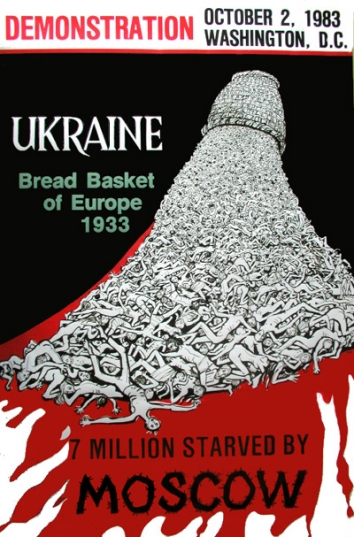Featured Galleries USUBC COLLECTION OF OVER 160 UKRAINE HISTORIC NEWS PHOTOGRAPHS 1918-1997
 Holodomor Posters
Holodomor Posters

Slowdown in rapid-growth markets to be short-lived
 Ernst & Young LLC, Kyiv, Ukraine
Ernst & Young LLC, Kyiv, Ukraine
16 July, 2012
- GDP to fall in 2012 but bounce back expected in 2013
- RGM households with income of more than US$30k to more than double by 2020 overtaking US and Eurozone
LONDON, KYIV, 13 July 2012 – Economic expansion in the 25 leading rapid-growth markets (RGMs) has started to slow sharply since the beginning of this year but this will only be a temporary blip according to Ernst & Young’s quarterly Rapid-Growth Markets Forecast (RGMF) released today.
RGMs, particularly in Asia, have the necessary tools available to ease both fiscal and monetary policy allowing growth to resume towards the end of the year.
Even with a slowdown in growth, RGMs are likely to weather the Eurozone crisis and will remain the engines of global growth. GDP is forecast to expand by 4.9% this year in stark contrast to the 0.6% contraction, at best, that is expected in the Eurozone. Output in the RGMs is expected to continue to pick up by 6% in 2013 and 6.5% in 2014.
However, there is a mixed picture emerging across the world. Asia and Africa continue to remain resilient but Central and Eastern Europe and Latin America are hindered by the slow growth in their key export markets of the Eurozone and United States respectively. If the Eurozone were to fall further into recession, RGMF predicts that the Czech Republic and Poland would be pushed into recession, with Hong Kong and Malaysia also hit hard due to their dependence on global trade.
Carl Astorri, Senior Economic Adviser to Ernst & Young’s Rapid Growth Markets Forecast explains, “The RGMs are well placed to weather the major risks facing the global economy at the present time, given that they have the space to relax fiscal and monetary policy. This has already happened in some RGMs including in all of the BRICs. It is likely that there will be further easing of monetary policy in the months ahead, particularly if the global economy deteriorates further.”
Alexis Karklins-Marchay, Co-Leader of the Emerging Markets Center at Ernst & Young comments, “Although slower expansion in the rapid-growth markets is likely this year it will only be a blip and we will see a return to significant growth towards the end of the year. Soaring domestic demand in economies starved, for some time, of investment and consumption will offer business exciting new markets for goods and services in the years ahead.”
Growing consumer markets to protect RGMs
As well as having the option of easing fiscal and monetary policy to accelerate growth, RGMs are also fortunate enough to have a growing middle class with increasingly higher incomes and an appetite to spend. RGMF forecasts that the number of households in RGMs enjoying higher incomes will grow sharply over the next ten years. The number of RGM households receiving an income of over US$30,000 will more than double reaching 149m by 2020, overtaking the US (120m) and the Eurozone (116m).
The growth in household incomes will lead to increased consumer spending. In 2011, two-thirds of consumer spending across the world came from the advanced economies, with the remaining third coming from the emerging markets. However, in 25 years time emerging Asia alone will have overtaken the advanced economies as the key source of consumer spending, responsible for almost 40%.
Alexis continues, “Consumer demand from RGMs will eventually replace the advanced economies as the key driver of global growth. The shift in import demand should also assist in rebalancing the economy.”
Rebalancing required
The rapidly growing Asian countries are enjoying more prominence in the world economy. This places greater importance on the role these countries must play in efforts to rebalance the global economy. Those countries that have run surpluses in recent years must adjust their growth patterns toward more reliance on domestic demand and should allow greater exchange rate flexibility.
Alexis comments, “Rebalancing Asian RGMs will not only make the world economy more stable but will also help the Asian countries themselves, making higher growth rates more durable. By increasing private consumption and investment and infrastructure spending, large gains can be made across Asia.”
As the RGMs develop, demand for services in these countries will increase sharply. The three key segments of the services market are financial, business and insurance; social security; and wholesale. Across the world, emerging markets currently account for less than a quarter of the services sector globally. But in 25 years’ time, it is estimated that emerging markets will make up more than 40% of the services sector across the world. Foreign direct investment (FDI) is now also beginning to shift focus away from manufacturing towards the services sector as it grows in importance.
Foreign investors drawn to RGMs
The current bout of the Eurozone crisis will have a negative impact on FDI into RGMs during 2012, with RGMF predicting a possible drop of 10%. However, longer-term FDI will continue to grow as companies are drawn to the high growth rates of the RGMs when growth is stagnant elsewhere in the world.
In the short-term weakness will be particularly apparent in the European economies with Central and Eastern Europe being hit hardest. But FDI into Russia and India could also lose momentum.
It is already evident that foreign investors are also beginning to spread their investments across the globe and that FDI is becoming more broad-based. In 2010 the majority of the overall increase in FDI was generated by just three countries – China, Brazil and Indonesia. However, in 2011 substantial increases were also recorded by Turkey and Colombia as well as Indonesia and all of the BRICs.
Ukraine: growth prospects dependent on gas exports and EU demand
The slowdown to 2.0% GDP growth in Q1 2012 reflects mounting constraints on industrial exports and domestic investment. But recession should still be avoided and slack demand will force efficiency improvement as well as containing inflation.
Rising energy costs and weakening export markets widened the current account deficit sharply to almost 6% of GDP in 2011. External financing constraints will persist this year, with IMF funding still suspended, but the situation should improve after elections at the end of October.
Lower inflation, with prices falling by 0.5% in May, has enabled the central bank to reduce interest rates, signaling confidence in external financing and the stability of the Ukrainian Hryvnia (UAH) — although price pressures will rise later in the year.
An EU association agreement is ready for approval and anticipation of a positive trade impact could boost inward investment from 2013. But relations with the EU appear to be on hold until after the elections and relations with the IMF remain complicated by the retention of energy subsidies.
Alexei Kredisov, Country Managing Partner for Ukraine, Co-Leader of the Emerging Markets Center at Ernst & Young Global, comments: “According to the survey, reviving exports to the EU should see growth pick up to about 4.2% in 2013, despite difficulty in repeating last year’s record harvest. Annual growth rates approaching 6% should be seen in 2014–15, as the outlook for gas exports improves and recovering EU demand boosts exports and capital flows”.
Looking ahead
Alexis Karklins-Marchay concludes, “Despite the slowdown in growth experienced by the RGMs at the beginning of this year they will begin to bounce back towards the end of this year and in 2013. The ability to relax policy to boost growth, a growing middle class to aid consumer spending and a strong rise in FDI flows will ensure continued growth well into the future.”
About Ernst & Young
Ernst & Young is a global leader in assurance, tax, transaction and advisory services. Worldwide, our 152,000 people are united by our shared values and an unwavering commitment to quality. We make a difference by helping our people, our clients and our wider communities achieve their potential.
Ernst & Young expands its services and resources in accordance with clients’ needs throughout the CIS. 4000 professionals work at 18 offices in Moscow, St. Petersburg, Novosibirsk, Ekaterinburg, Kazan, Krasnodar, Togliatti, Yuzhno-Sakhalinsk, Almaty, Astana, Atyrau, Baku, Kyiv, Donetsk, Tashkent, Tbilisi, Yerevan, and Minsk.
Ernst & Young established its practice in Ukraine in 1991. Ernst & Young Ukraine now employs more than 500 professionals providing a full range of services to a number of multinational corporations and Ukrainian enterprises.
For more information about our organization, please visit www.ey.com/ua.
This news release has been issued by EYGM Limited, a member of the global Ernst & Young organization that also does not provide any services to clients.











